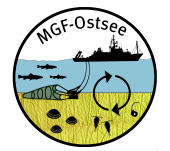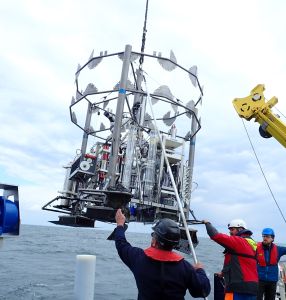Marine biological sampling
Whoever hears the word marine biology, quickly has romantic ideas: Swimming with dolphins, snorkeling in colorful coral reefs, diving among shoals of fish. Although this also happens, many marine biologists work in a different way. For weeks, expeditions with research ships and scientific equipment are carried out. Gears are then lowered into the water on wire ropes to collect water samples, animals and plants, sediments and rocks on the sea floor. Afterwards the scientist often have to work months or years in a laboratory.
Here we give insight into our scientific work.
Scientific vessels
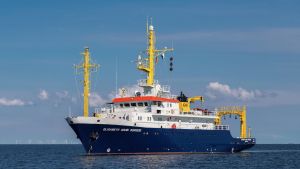
Here you can find portraits of the research ships we have used in the project so far:
IOW
Thünen-Institut
Large equipment/gears
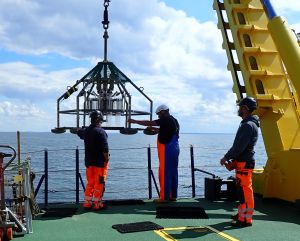
Multiple Corer or Multicorer (MUC)
The MUC is a large gear for sampling marine sediment, bottom waters and small organisms (protists, foraminifers, meiofauna) that inhabit the sediment. The gear consists of 12 plastic tubes, a movable head with weights, an iron frame and a hydraulic damper. Due to its design, it reduces bottom waves on the seabed that occur during landing of the MUC. Bottom waves would wash the uppermost sediment layers and attached organisms away. Thus the MUC enabling undisturbed sampling. With its plastic tubes the gear can sample up to 12 samples at the same time.
The principle of sampling: After the frame of the instrument is placed on the seabed, the weights on the head section press the plastic tubes into the sediment. When the tubes are pulled out of the bottom, a mechanism is triggered that firmly closes the lids on the tubes so that the water-sediment samples can be safely brought on deck of the research vessel.
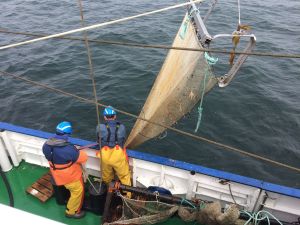
Beam trawl
Beam trawl is a special net that is used to catch animals living on the seabed (e.g. fish, crabs) and is used especially by fisheries. The net is kept open horizontally by a crossbar, also called a tree or a beam, made of wood or metal. On the sides of the crossbar there are runners with which the net is pulled over the ground. The net itself is attached behind the skids and the tree and has rollers at its front edge to prevent the net from getting stuck in the ground. Furthermore, these rollers are used to scare up animals (mostly crabs). For catching flatfish additional chains are often used.
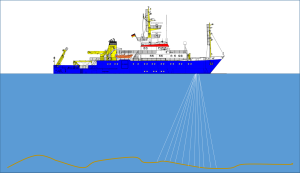
Hydroacoustics
Using so-called hydroacoustic systems such as multibeam echosounders, detailed maps of the sea floor can be produced. Such maps provide information about water depths, but can also provide information about the properties of the seabed.
Measurements with echosounders are based on the detection of emitted sound signals that are reflected at acoustic boundary layers such as the sea floor. With the measured time between transmission and reception of the sound signal and the speed of sound, the water depths can be calculated.
In order to determine the properties of the seabed, other factors, such as the scattering of the sound signal at the seabed, hast to be taken into account.
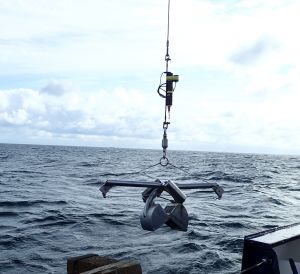
Van Veen grab
The Van Veen grab is a small dredging grab that is used to take sediment samples from the seabed. Before it is used, the small "dredging buckets" are opened and locked. When sinking into the bottom, the lock is released and both buckets snap shut. When the gear is pulled up, the shovels then firmly enclose the sample taken. The small grab unfortunately has a few disadvantages: For example, the sample you get is a mixed sample of the upper sediment layers and the penetration depth into the sediment cannot be determined exactly.
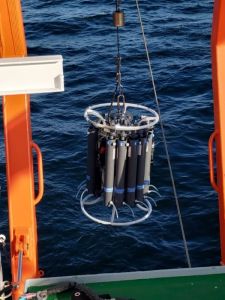
CTD
The CTD is a gear used to take water samples at sea to measure electrical conductivity (C), temperature (T) and depth (D). Other instruments can also be attached to the device e.g. to measure oxygen. The device itself consists of a cylindrical metal frame to which several removable water samplers are attached. The measuring instruments of the physical parameters are located in the center of the frame. The water samplers can be closed from a computer on board, so that water samples can be taken from different depths.
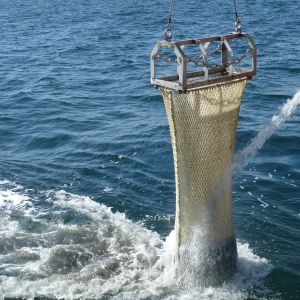
Dredge
The dredge is a trawl net, which is attached to a heavy metal frame with metal teeth and is pulled over the seabed by the research vessel to sample rocks or larger animals adhering to the bottom, such as starfish and mussels.
------------------------------------------------------------------------------------------------------------------------------------------------------------------------------------
